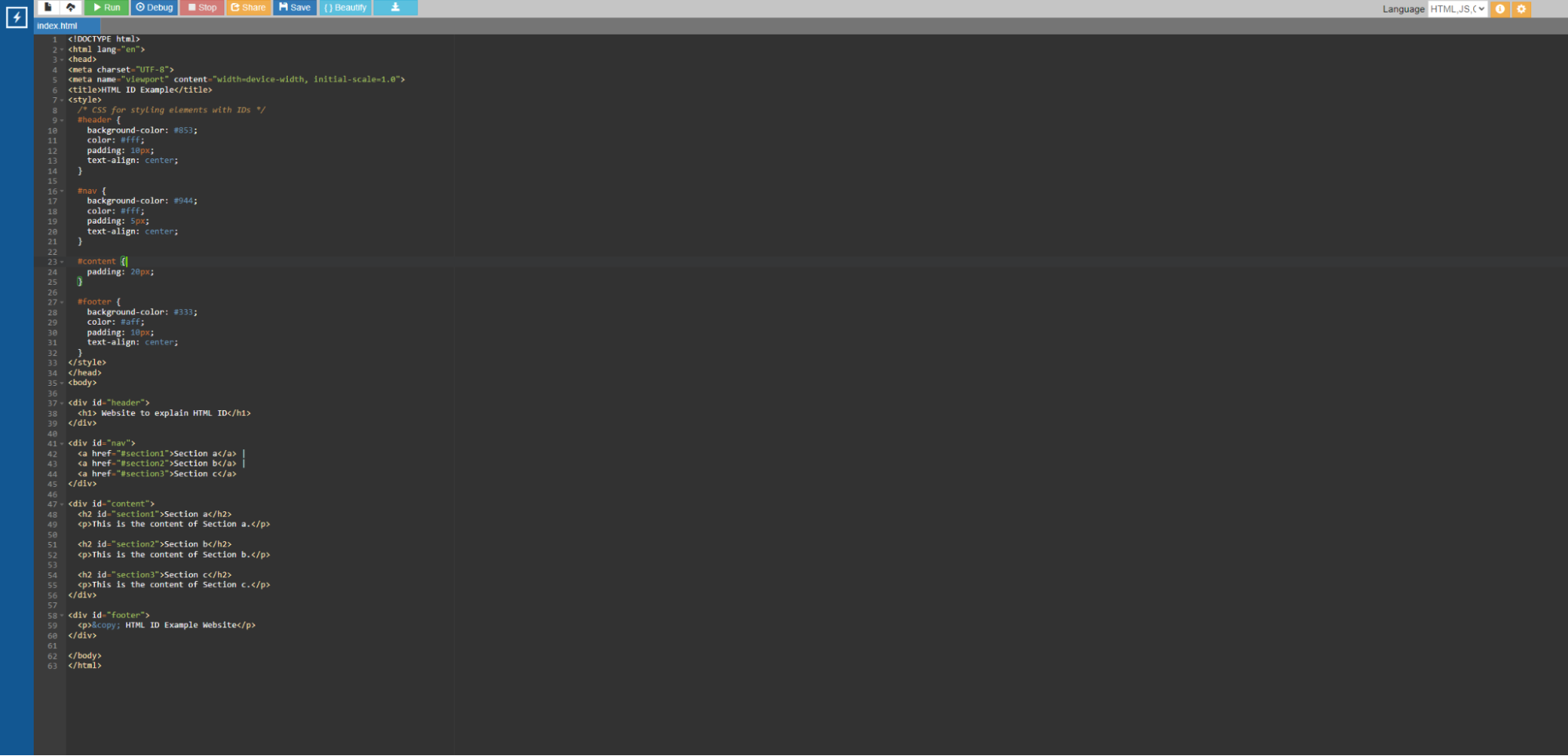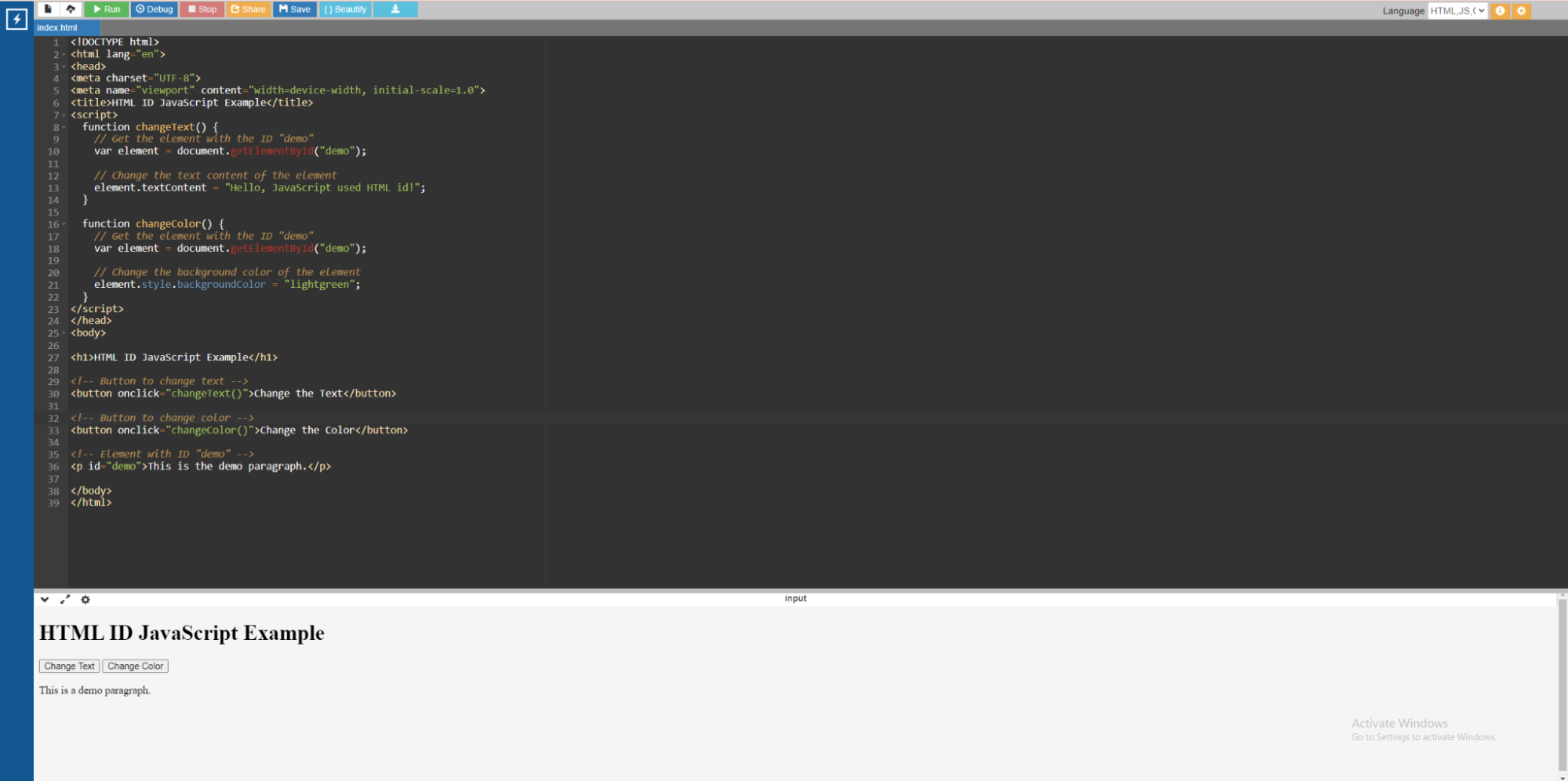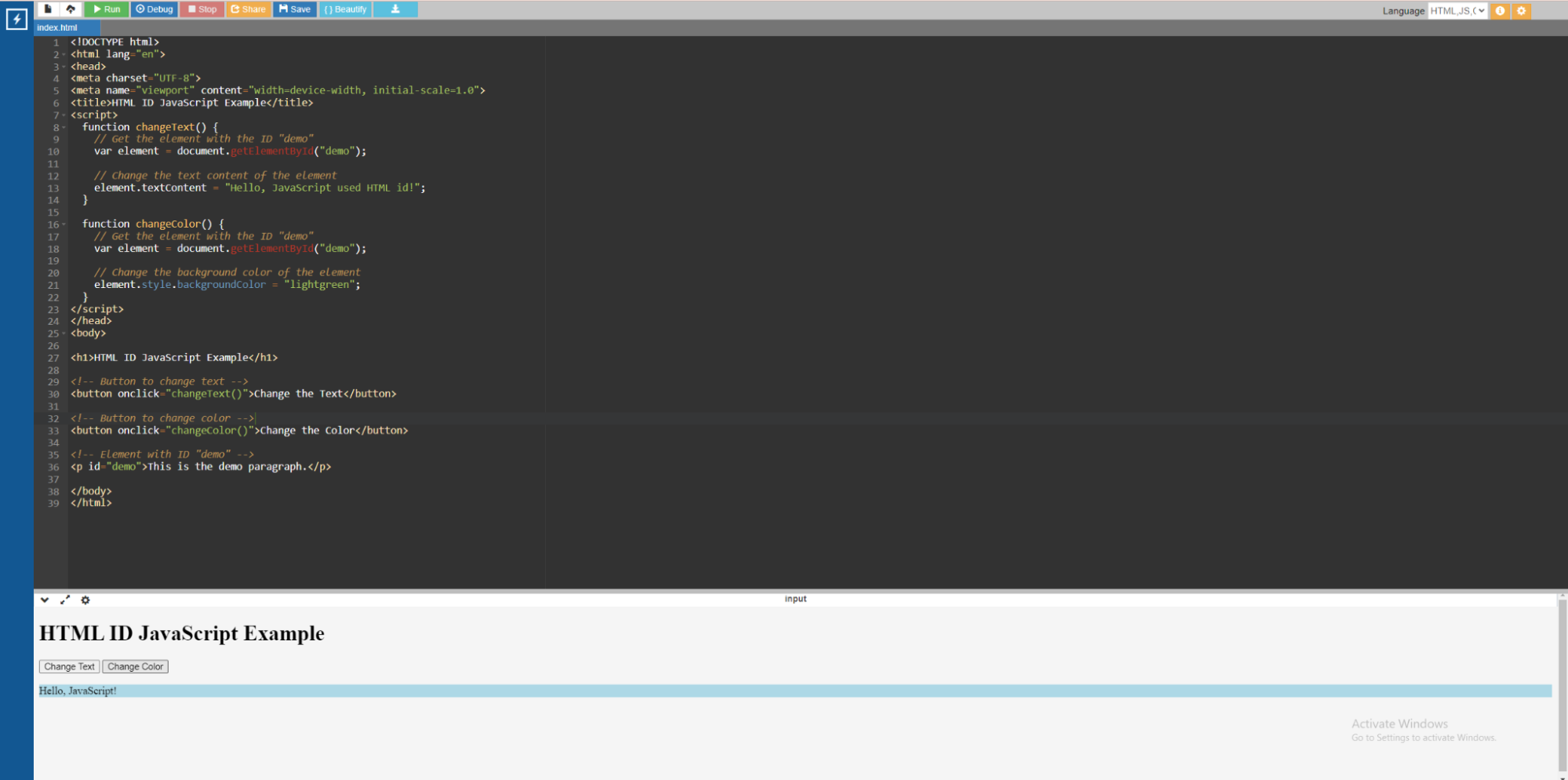Working professionals
Fresh graduates
- Study abroad
- Offline centres
More
2. HTML Basics
3. HTML Syntax
9. HTML Head
10. HTML Title
11. HTML Styles
12. HTML Paragraphs
13. HTML Symbols
14. HTML Emojis
15. HTML Formatting
16. HTML Entities
17. HTML Audio
18. HTML Images
19. HTML Lists
20. HTML Links
21. SVG in HTML
22. HTML Forms
23. HTML Video
24. HTML Canvas
25. Adjacency Lists
26. HTML Input Types
27. HTML Tables
31. HTML Layout
33. HTML Div
37. HTML Iframes
40. HTML Code
41. HTML Colors
42. HTML CSS
43. HTML Editors
44. HTML Examples
45. Class in HTML
46. HTML Exercises
47. HTML ID
49. HTML Table Style
50. HTML Script
HTML ID: Key to Efficient Web Development
When we create a web page, we use many HTML elements. Later, when we want to operate on a specific element using something like CSS, it often becomes difficult to target a single element. This is where the concept of HTML ID comes in. It helps us identify each element by assigning it a name that can be referred to.
As an HTML developer myself, I use the HTML ID attribute very frequently in my projects. Hopefully, after this tutorial, you will be able to use it in your future HTML projects as well!
What is HTML ID?
Before delving into the definition of HTML ID, you need to have a firm grasp of the concept of HTML. Consider going through the basics of HTML first.
Now, let’s talk about HTML ID.
An HTML ID is a unique attribute assigned to an HTML element in order to identify it within the document. IDs are primarily used for scripting and styling purposes. They enable developers to target specific elements with JavaScript for dynamic behavior or to apply specific styles to them with CSS.
Here’s how you can incorporate it into your project. Look at the below example:
<div id="uniqueID">This is an element with an ID attribute in HTML.</div>
In this case, the <div> element is assigned the HTML ID "uniqueID". We used the id tag in HTML. It is also important to keep in mind that IDs must be unique within the HTML document. This means no two elements should share the same ID. This unique trait ensures that individual elements can be reliably targeted and manipulated in scripting or styling using their HTML IDs.
Advantages of using HTML ID
Here are the benefits of using HTML ID in your project.
- Identify elements: The HTML ID attribute enables you to uniquely identify individual elements in an HTML document. This distinction is critical for precisely targeting specific elements, particularly in scripting and styling tasks.
- Targeting an element during scripting: HTML IDs allow you to precisely target and manipulate specific elements using JavaScript or other scripting languages. This is especially useful for dynamic web applications that require updating or interacting with specific elements in response to user actions.
- Styling with CSS: IDs allow you to apply specific styles to individual elements. This targeted styling aids in the creation of custom designs and layouts, which enhances the visual appeal and user experience of web pages.
- SEO optimization: Search engine crawlers can use IDs to determine the structure and hierarchy of content on a website. This may improve search engine optimization (SEO) by providing clearer indications of the page's content organization.
- Improves document structure: IDs can be used to identify key sections or elements within a document, resulting in a well-structured and organized HTML hierarchy. This makes the codebase more understandable and maintainable.
Elements That Support the HTML ID Attribute
Let’s further discuss all the HTML elements to which you can assign an HTML ID. Here is a list of HTML elements that support HTML ID.
Sections and divisions
Elements such as <div> and <section> are frequently assigned IDs to divide the webpage into logical sections, making it easier to target specific content.
Headings
IDs are commonly assigned to headings like <h1> to <h6> to help navigate long documents or create anchor links.
Links and anchors
Anchor elements <a> use IDs as targets for internal links ('<a>tags withhref="#id"' attribute), allowing users to navigate specific sections of a page.
HTML elements
If we think about it, any HTML element can be assigned an HTML ID. This includes elements such as <div>, <span>, <p>, <h1> to <h6>, <ul>, <ol>, <li>, <a>, <img>, <form>, <input>, <button>, <table>, <tr>, <td>, and many more.
Form elements
Form elements, including <form>, <input>, <textarea>, <select>, and <button>, can be identified using IDs for scripting or validation.
Table elements
Table-related elements, such as <table>, <tr>, <td>, <th>, and <caption>, can use IDs to manipulate or style individual table components.
Images
IDs can be used in scripting tasks or to create clickable image maps with specific regions linked to IDs.
Navigation elements
IDs are commonly used to link sections or pages in navigation menu elements such as <nav>, <ul>, <ol>, <li>, and <a>.
Interactive elements
IDs can be assigned to elements such as <button>, <input type="checkbox">, <input type="radio">, and <input type="submit"> to facilitate scripting and form handling.
HTML ID example
Now that we know how HTML ID works, let me share an ID attribute in HTML example. This will give you an idea of industry common practices.

Code:
<!DOCTYPE html>
<html lang="en">
<head>
<meta charset="UTF-8">
<meta name="viewport" content="width=device-width, initial-scale=1.0">
<title>HTML ID Example</title>
<style>
/* CSS for styling elements with IDs */
#header {
background-color: #853;
color: #fff;
padding: 10px;
text-align: center;
}
#nav {
background-color: #944;
color: #fff;
padding: 5px;
text-align: center;
}
#content {
padding: 20px;
}
#footer {
background-color: #333;
color: #aff;
padding: 10px;
text-align: center;
}
</style>
</head>
<body>
<div id="header">
<h1> Website to explain HTML ID</h1>
</div>
<div id="nav">
<a href="#section1">Section a</a> |
<a href="#section2">Section b</a> |
<a href="#section3">Section c</a>
</div>
<div id="content">
<h2 id="section1">Section a</h2>
<p>This is the content of Section a.</p>
<h2 id="section2">Section b</h2>
<p>This is the content of Section b.</p>
<h2 id="section3">Section c</h2>
<p>This is the content of Section c.</p>
</div>
<div id="footer">
<p>© HTML ID Example Website</p>
</div>
</body>
</html>
In the above example,
- To style the elements like header, navigation, content, and footer sections, we have used HTML IDs like #header, #nav, #content, and #footer.
- Each div, like footer, content, etc., has been given a unique div ID in HTML.
- Anchor links ('<a>') in the navigation (#nav) point to specific sections (#section1, #section2, #section3) in the content area.
- Each section in the content area (#section1, #section2, and #section3) is assigned an ID for internal linking and styling using id HTML CSS.
HTML ID Using JavaScript
We can also use Javascript to manipulate elements using id tag in HTML Let me demonstrate this using an example HTML program.


Code:
<!DOCTYPE html>
<html lang="en">
<head>
<meta charset="UTF-8">
<meta name="viewport" content="width=device-width, initial-scale=1.0">
<title>HTML ID JavaScript Example</title>
<script>
function changeText() {
// Get the element with the ID "demo"
var element = document.getElementById("demo");
// Change the text content of the element
element.textContent = "Hello, JavaScript used HTML id!";
}
function changeColor() {
// Get the element with the ID "demo"
var element = document.getElementById("demo");
// Change the background color of the element
element.style.backgroundColor = "lightgreen";
}
</script>
</head>
<body>
<h1>HTML ID JavaScript Example</h1>
<!-- Button to change text -->
<button onclick="changeText()">Change the Text</button>
<!-- Button to change color -->
<button onclick="changeColor()">Change the Color</button>
<!-- Element with ID "demo" -->
<p id="demo">This is the demo paragraph.</p>
</body>
</html>
In the above example,
- We have two JavaScript functions (changeText and changeColor) that show how to edit items using their HTML ID.
- The changeText function modifies the text content of the element with ID "demo," whereas the changeColor function modifies the background color of the same element.
- These functions are activated by buttons, which, when clicked, call the corresponding functions.
Summing Up
HTML ID is a powerful tool for uniquely identifying and interacting with elements, customizing styling, improving accessibility, supporting document structure, and improving the web user experience.
To further understand HTML concepts, it is a smart choice to check out certified courses. I would strongly recommend courses from upGrad. They offer courses in collaboration with some of the best universities around the world, and some of the best professors in this field curate their courses.
Frequently Asked Questions
1. What is an HTML ID?
An HTML ID is a unique identifier for an element in an HTML document. It is used to uniquely identify and target a specific element in CSS for styling or in JavaScript for interactivity and manipulation. How is an HTML ID different from a class?
2. How is an HTML ID different from a class?
An HTML ID uniquely identifies a single element, whereas a class applies the same styling or behavior to multiple elements. IDs must be unique within a document, whereas classes can be used on multiple elements. How do you assign an ID to an HTML element?
3. How do you assign an ID to an HTML element?
To assign an ID to an HTML element, place the id attribute within the element's opening tag. What is data ID in HTML?
4. What is data ID in HTML?
There is nothing called data-id in HTML. However, the id attribute, which we have discussed extensively in the article, is used for a different purpose, such as uniquely identifying elements for styling or scripting with JavaScript. What is the form id in HTML?
5. What is the form id in HTML?
The form ID in HTML is a unique identifier assigned to a
6. How to find HTML elements by ID?
You cannot find HTML elements by id in HTML. We can assign an ID to each HTML element. However, in JavaScript, we can use the function getElementById() to find an HTML element by id. You cannot find HTML elements by id in HTML. We can assign an ID to each HTML element. However, in JavaScript, we can use the function getElementById() to find an HTML element by id. Can an HTML document have multiple elements with the same ID?
7. Can an HTML document have multiple elements with the same ID?
Although HTML elements can have multiple elements with the same HTML ID, they should not. The id attribute in HTML is used to identify a single element within a document uniquely. Having multiple elements with the same ID can cause bugs. Can you use special characters in HTML IDs?
8. Can you use special characters in HTML IDs?
IDs in HTML are case-sensitive. HTML IDs can contain letters, numbers, hyphens (-), underscores (_), and periods. However, in the case of HTML IDs, the usage of special characters like spaces, commas, colons, semicolons, slashes, backslashes, and question marks is prohibited.

Author|310 articles published


upGrad Learner Support
Talk to our experts. We are available 7 days a week, 10 AM to 7 PM
Indian Nationals
Foreign Nationals
Disclaimer
The above statistics depend on various factors and individual results may vary. Past performance is no guarantee of future results.
The student assumes full responsibility for all expenses associated with visas, travel, & related costs. upGrad does not .






















-7f4b4f34e09d42bfa73b58f4a230cffa.webp&w=128&q=75)
-ae8d039bbd2a41318308f8d26b52ac8f.svg)



